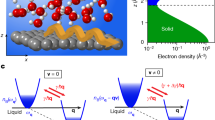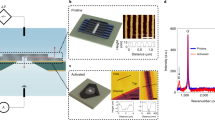Abstract
The emergence of the field of nanofluidics in the last decade1 has led to the development of important applications including water desalination2, ultrafiltration2 and osmotic energy conversion3. Most applications make use of carbon nanotubes4, boron nitride nanotubes2, graphene5,6 and graphene oxide5. In particular, understanding water transport in carbon nanotubes is key for designing ultrafiltration devices2 and energy-efficient water filters1,4. However, although theoretical studies based on molecular dynamics simulations7,8,9 have revealed many mechanistic features of water transport at the molecular level, further advances in this direction are limited by the fact that the lowest flow velocities accessible by simulations7,8,9 are orders of magnitude higher than those measured experimentally4,10,11,12,13. Here, we extend molecular dynamics studies of water transport through carbon nanotubes to flow velocities comparable with experimental ones using massive crowd-sourced computing power. We observe previously undetected oscillations in the friction force between water and carbon nanotubes and show that these oscillations result from the coupling between confined water molecules and the longitudinal phonon modes of the nanotube. This coupling can enhance the diffusion of confined water by more than 300%. Our results may serve as a theoretical framework for the design of new devices for more efficient water filtration and osmotic energy conversion devices.
This is a preview of subscription content, access via your institution
Access options
Subscribe to this journal
Receive 12 print issues and online access
$259.00 per year
only $21.58 per issue
Buy this article
- Purchase on Springer Link
- Instant access to full article PDF
Prices may be subject to local taxes which are calculated during checkout



Similar content being viewed by others
References
Sparreboom, W., van den Berg, A. & Eijkel, J. C. T. Principles and applications of nanofluidic transport. Nature Nanotech. 4, 713–720 (2009).
Shannon, M. A. et al. Science and technology for water purification in the coming decadesie. Nature 452, 301–310 (2008).
Siria, A. et al. Giant osmotic energy conversion measured in a single transmembrane boron nitride nanotube. Nature 494, 455–458 (2013).
Holt, J. K. et al. Fast mass transport through sub-2-nanometer carbon nanotubes. Science 312, 1034–1037 (2006).
Nair, R. R., Wu, H. A., Jayaram, P. N., Grigorieva, I. V. & Geim, A. K. Unimpeded permeation of water through helium-leak-tight graphene-based membranes. Science 335, 442–444 (2012).
Tocci, G., Joly, L. & Michaelides, A. Friction of water on graphene and hexagonal boron nitride from ab initio methods: very different slippage despite very similar interface structures. Nano Lett. 14, 6872–6877 (2014).
Kannam, S. K., Todd, B. D., Hansen, J. S. & Daivis, P. J. How fast does water flow in carbon nanotubes? J. Chem. Phys. 138, 094701 (2013).
Ma, M. D. et al. Friction of water slipping in carbon nanotubes. Phys. Rev. E 83, 036316 (2011).
Falk, K., Sedlmeier, F., Joly, L., Netz, R. R. & Bocquet, L. Molecular origin of fast water transport in carbon nanotube membranes: superlubricity versus curvature dependent friction. Nano Lett. 10, 4067–4073 (2010).
Qin, X. C., Yuan, Q. Z., Zhao, Y. P., Xie, S. B. & Liu, Z. F. Measurement of the rate of water translocation through carbon nanotubes. Nano Lett. 11, 2173–2177 (2011).
Majumder, M., Chopra, N. & Hinds, B. J. Mass transport through carbon nanotube membranes in three different regimes: ionic diffusion and gas and liquid flow. ACS Nano 5, 3867–3877 (2011).
Cao, D. et al. Electronic sensitivity of carbon nanotubes to internal water wetting. ACS Nano 5, 3113–3119 (2011).
Whitby, M., Cagnon, L., Thanou, M. & Quirke, N. Enhanced fluid flow through nanoscale carbon pipes. Nano Lett. 8, 2632–2637 (2008).
Bocquet, L. & Barrat, J. L. On the Green–Kubo relationship for the liquid–solid friction coefficient. J. Chem. Phys. 139, 044704 (2013).
Hanasaki, I. & Nakatani, A. Flow structure of water in carbon nanotubes: Poiseuille type or plug-like? J. Chem. Phys. 124, 144708 (2006).
Huang, D. M., Sendner, C., Horinek, D., Netz, R. R. & Bocquet, L. Water slippage versus contact angle: a quasiuniversal relationship. Phys. Rev. Lett. 101, 226101 (2008).
Weaver, W. Jr, Timoshenko, S. P. & Young, D. H. Vibration Problems in Engineering 5th edn (Wiley-Interscience, 1990).
Wang, L. F., Zheng, Q. S., Liu, J. Z. & Jiang, Q. Size dependence of the thin-shell model for carbon nanotubes. Phys. Rev. Lett. 95, 105501 (2005).
Bahar, I., Lezon, T. R., Bakan, A. & Shrivastava, I. H. Normal mode analysis of biomolecular structures: functional mechanisms of membrane proteins. Chem. Rev. 110, 1463–1497 (2010).
Urbakh, M. & Daikhin, L. Roughness effect on the frequency of a quartz-crystal resonator in contact with a liquid. Phys. Rev. B 49, 4866–4870 (1994).
Tshiprut, Z., Filippov, A. E. & Urbakh, M. Tuning diffusion and friction in microscopic contacts by mechanical excitations. Phys. Rev. Lett. 95, 016101 (2005).
Feller, W. An Introduction to Probability Theory and its Applications 3rd edn (Wiley, 1968).
Detcheverry, F. & Bocquet, L. Thermal fluctuations in nanofluidic transport. Phys. Rev. Lett. 109, 024501 (2012).
Zhang, R. et al. Superlubricity in centimetres-long double-walled carbon nanotubes under ambient conditions. Nature Nanotech. 8, 912–916 (2013).
Krasheninnikov, A. V. & Banhart, F. Engineering of nanostructured carbon materials with electron or ion beams. Nature Mater. 6, 723–733 (2007).
Iijima, S., Brabec, C., Maiti, A. & Bernholc, J. Structural flexibility of carbon nanotubes. J. Chem. Phys. 104, 2089–2092 (1996).
Abascal, J. L. F. & Vega, C. A general purpose model for the condensed phases of water: TIP4P/2005. J. Chem. Phys. 123, 234505 (2005).
Mayo, S. L., Olafson, B. D. & Goddard, W. A. III . Dreiding—a generic force-field for molecular simulations. J. Phys. Chem. 94, 8897–8909 (1990).
Plimpton, S. Fast parallel algorithms for short-range molecular-dynamics. J. Comput. Phys. 117, 1–19 (1995).
Computing for Clean Water Project Statistics; http://www.worldcommunitygrid.org/stat/viewProject.do?projectShortName=c4cw
Acknowledgements
The authors thank the thousands of volunteers who have contributed to the Computing for Clean Water project for their enthusiastic support. The authors thank A. Michaelides and G. Aeppli for discussions. This research was undertaken with the assistance of resources from the National Computational Infrastructure (NCI), which is supported by the Australian Government.
Author information
Authors and Affiliations
Contributions
F.G., M.M. and Q.S.Z. proposed and designed the project. M.M. performed MD simulations, data analysis and theoretical analysis. F.G. coordinated the project and participated in data analysis. L.M.S. participated in the design of the MD simulations set-up and provided key resources for test simulations and data analysis. M.U. performed theoretical analysis and participated in data analysis. M.M., F.G., M.U. and Q.S.Z. wrote the manuscript. L.M.S., S.W., J.Z.L. and Y.L.L. participated in data analysis and manuscript preparation.
Corresponding authors
Ethics declarations
Competing interests
The authors declare no competing financial interests.
Supplementary information
Supplementary information
Supplementary Information (PDF 1401 kb)
Rights and permissions
About this article
Cite this article
Ma, M., Grey, F., Shen, L. et al. Water transport inside carbon nanotubes mediated by phonon-induced oscillating friction. Nature Nanotech 10, 692–695 (2015). https://doi.org/10.1038/nnano.2015.134
Received:
Accepted:
Published:
Issue Date:
DOI: https://doi.org/10.1038/nnano.2015.134
This article is cited by
-
Interplay of the forces governing steroid hormone micropollutant adsorption in vertically-aligned carbon nanotube membrane nanopores
Nature Communications (2024)
-
Enhanced osmotic transport in individual double-walled carbon nanotube
Nature Communications (2023)
-
Scaling of ionic conductance in a fluctuating single-layer nanoporous membrane
Scientific Reports (2023)
-
Electrohydrodynamic direct-writing shaped fibers via pumping based on Micro-Weissenberg effect
Applied Physics A (2023)
-
Interfacial friction at action: Interactions, regulation, and applications
Friction (2023)



